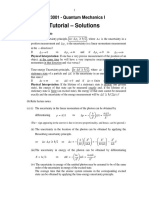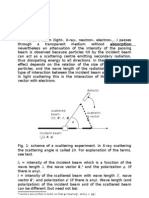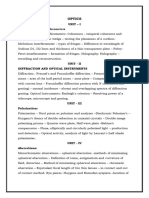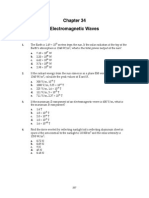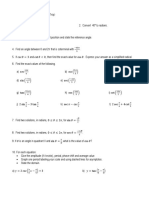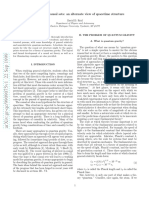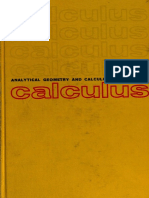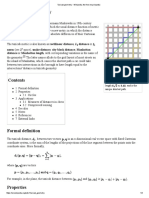Solution 10
Solution 10
Uploaded by
Narendra KumarCopyright:
Available Formats
Solution 10
Solution 10
Uploaded by
Narendra KumarCopyright
Available Formats
Share this document
Did you find this document useful?
Is this content inappropriate?
Copyright:
Available Formats
Solution 10
Solution 10
Uploaded by
Narendra KumarCopyright:
Available Formats
MASSACHUSETTS INSTITUTE OF TECHNOLOGY
Department of Physics
Problem Solving 10: Plane Electromagnetic Waves, Poynting Energy
Flow, and Interference Solutions
OBJECTIVES
1. To introduce the concept of energy flow through space due to plane sinusoidal
traveling electromagnetic waves.
2. To quantify that energy flow by introducing the Poynting vector.
3. To quantify the concept of radiation pressure.
4. To develop an order of magnitude feel for the energy flow from the sun into the
earths atmosphere
5. To understand the meaning of constructive and destructive interference
6. To understand how to determine the interference conditions for double slit
interference
7. To understand how to apply the interference conditions for diffraction
REFERENCE: Course Notes: Sections 13-1-13-7, 14-1 through 14-7, 14.9
http://web.mit.edu/8.02t/www/materials/StudyGuide/guide14.pdf
Problem 1: Plane Electromagnetic Waves Consider a sinusoidal plane elecctromagnetic
wave given by the expression
!
E(x,t) = E
x
(z,t)
i = E
0
cos(kz +!t)
i .
Question 1: What is the direction of propagation of this electromagnetic plane wave?
Answer: If we have a traveling wave of the form
cos(!t + kz) , the wave propagates in
the negative
z -direction (
!
k -direction). To see this plot the wave at
t = 0 , and also at
t = !t . The zeros and peaks of the waveform shift in the negative
z -direction as time
progresses.
Question 2: Determine the relation between
! and
k for this field to satisfy Maxwells
wave equation for the electric field,
1
c
2
!
2
E
x
!t
2
=
!
2
E
x
!z
2
?
Answer: We first take two derivatives with respect to
x .
!E
x
!z
=
!
!z
(E
0
cos(kz +"t)) = #kE
0
sin(kz +"t)
!
2
E
x
!z
2
=
!
!z
("kE
0
sin(kz +#t)) = "k
2
E
0
cos(kz +#t) .
We now take two derivatives with respect to
t .
!E
x
!t
=
!
!t
(E
0
cos(kz +"t)) = wkE
0
sin(kz +"t)
!
2
E
x
!t
2
=
!
!t
("#E
0
sin(kz +#t)) = "#
2
E
0
cos(kz +#t) .
We now use the wave equation to find the relationship between
! and
k
:
1
c
2
!
2
E
x
!t
2
=
!
2
E
x
!z
2
"
#
$
2
c
2
E
0
cos(kz +$t) = #k
2
E
0
cos(kz +$t) "
$ = kc
Note that we take the positive square root because both
! > 0 and
k > 0
.
Question 3: Find an expression for the direction and magnitude of the magnetic field
associated with this plane electromagnetic wave.
Answer: Because
dir(
!
E) ! dir(
!
B) = dir(
!
E!
!
B) = dir(
!
S) = dir( propagation) , at a point
(z,t) such that
cos(kz +!t) > 0 ,
dir(
!
E) =
i ,
dir( propagation) = !
k . Hence
i ! dir(
!
B) = "
k . Therefore
dir(
!
B) = !
j. We know that the magnitudes of
!
E and
!
B are
related by
B
0
= E
0
/ c . Therefore the magnetic field is given by
!
B = !
E
0
c
cos(kz +"t)
j .
Question 4: What is the Poynting vector
!
S=
1
0
!
E!
!
B associated with this wave?
Answer:
!
S=
1
0
!
E!
!
B =
E
0
2
c
0
cos
2
(kz +"t)(#
k) .
Question 5: The definition of a time average of a periodic function
f (t) over one period
is given by the integral expression
f (t) =
1
T
f (t) dt
0
T
!
.
The time-averaged value of the square of the sine function is
2
1
sin
2 2
t
! " #
$ + =
% &
' (
.
What is the time-average of the Poynting vector
!
S ?
Recall that
c
2
=1/
0
!
0
.
Answer:
!
S =
1
T
E
0
2
c
0
cos
2
(kz +!t )dt("
k) =
0
T
#
E
0
2
2c
0
("
k) =
1
2
c $
0
E
0
2
("
k).
where we used the relationship
c
2
=1/
0
!
0
Problem 2 Poynting Vector and Radiation Pressure
Introduction
A plane electromagnetic wave transports energy in the direction of propagation of the
wave. The power per square area is given by the Poynting vector
!
S =
!
E!
!
B
0
.
The power that flows into the rectangular volume cross-sectional area
A and length
c!t
appears as rate of change of the energy stored in the fields inside the volume.
P
power
=
!
S A =
d
dt
U
total
.
The electromagnetic wave also transports momentum, and hence can exert a radiation
pressure on a surface due to the absorption and reflection of the momentum.
The momentum carried by an electromagnetic wave is related to the energy of the wave
according to
U = c
!
p
If the plane electromagnetic wave is completely absorbed by a surface of cross-sectional
area A then the momentum p !
!
delivered to the surface in a time t ! is given by
!
!
p =
!U
c
.
The force that the wave exerts on the surface is then the rate of change of the momentum
in time
F = lim
!t "0
!
!
p
!t
= lim
!t "0
1
c
!U
!t
=
1
c
dU
dt
.
Since the rate of change of energy is related to the power flowing across the surface, the
force is
F =
1
c
dU
dt
=
1
c
P
power
=
1
c
!
S A.
The radiation pressure
P
pressure
is then defined to be the force per area that the wave
exerts on the surface
P
pressure
abs
!
F
A
=
1
c
!
S , perfectly absorbing.
When the surface completely reflects the wave, then the change in momentum is twice
the absorbing case since the wave completely reverses direction,
!
!
p = 2
!U
c
.
Therefore the radiation pressure of a wave on a perfectly reflecting surface is
P
pressure
ref
!
F
A
= 2
1
c
!
S , perfectly reflecting.
Radiation Pressure: Solar Sail
Suppose you want to sail a space capsule through the solar system by using the force
due to the radiation pressure from the suns light to balance the gravitational attraction
from the sun. Imagine that the mass of the capsule and the sail is
1000 kg, that the
circular sail is perfectly reflective, and that it is oriented face-on to the sun. The
luminosity of the sun is
P
sun
= 4 !10
26
J/sec or alternatively the solar constant is
1.4 !10
3
W" m
-2
at the top of the earths atmosphere. The mass of the sun is
1.99 !10
30
kg . Note all of the above quantities are time-averaged.
Question 1: At a distance
r from the sun, the total power output of the sun is spread over
a spherical area
4!r
2
. Determine the time-averaged value of the magnitude of the
Poynting vector on the spherical surface at a distance
r from the sun.
Answer: The magnitude of the Poynting vector on the spherical surface is given by
S(r) =
P
sun
4!r
2
.
Question 2: Determine the radiation pressure on the solar sail at a distance
r from the
sun. You may assume that the solar sail is a perfectly reflecting object.
Answer:
P
rad
ref
(r) = 2
1
c
S(r) .
Question 3: Determine the radiation force on the solar sail
A that has area at a distance
r from the sun.
Answer: The radiation force on the perfectly reflecting solar sail is given by
F
rad
ref
(r) = P
rad
ref
(r) A=
2S(r) A
c
=
2P
sun
A
c4!r
2
.
Question 4: The minimum sail area necessary to balance the radiation force and the
attractive gravitational force can be found by setting
F
rad
ref
(r) = F
grav
(r) . Using the
universal law of gravity (magnitude given by
F
grav
(r) = Gm
sun
m/ r
2
). Assume the sail is
what is the minimum area for the sail in order to exactly balance the gravitational
attraction from the sun?
Answer: This force balance occurs when
2P
sun
A
min
c4!r
2
=
Gm
sun
m
r
2
.
Therefore the minimum area is
A
min
=
Gm
sun
mc4!
2P
sun
=
6.67 "10
#11
$
%
&
'
1.99 "10
30
kg
$
%
&
'
1000kg $
%
&
'
2! $
%
&
'
3"10
8
m/ sec
$
%
&
'
4 "10
26
J/sec
$
%
&
'
= 6.26 "10
5
m
2
= 0.626 km
2
.
If we assume a circular sail, then the diameter
d of the sail is given by
d = 2 A/ ! = 0.89 km.
Question 5: Does the minimum area for the sail depend on how far the sail is away from
the sun? Explain your reasoning.
Answer: The minimum area that we found is independent of the distance from the sun.
The reason is that both the magnitude of the gravitational force and the magnitude of the
Poynting vector vary as
1/ r
2
.
Problem 3 Interference
Introduction
The Huygens Principle states that every unobstructed point on a wavefront will act a
source of a secondary spherical wave. We add to this principle, the Superposition
Principle that the amplitude of the wave at any point beyond the initial wave front is the
superposition of the amplitudes of all the secondary waves.
Figure 1: Huygens-Fresnel Principle applied to double slit
When ordinary light is emitted from two different sources and passes through two narrow
slits, the plane waves do not maintain a constant phase relation and so the light will show
no interference patterns in the region beyond the openings. In order for an interference
pattern to develop, the incoming light must satisfy two conditions:
The light sources must be coherent. This means that the plane waves from the
sources must maintain a constant phase relation.
The light must be monochromatic. This means that the light has just one
wavelength.
When coherent monochromatic laser light falls on two slits separated by a distance d ,
the emerging light will produce an interference pattern on a viewing screen a distance D
from the center of the slits. The geometry of the double slit interference is shown in the
figure below.
Consider light that falls on the screen at a point P a distance y from the point O that
lies on the screen a perpendicular distance D from the double slit system. The light from
the slit 2 will travel an extra distance
2 1
r r r ! = " to the point P than the light from slit 1.
This extra distance is called the path length.
Question 1: Draw a picture of two traveling waves that add up to form constructive
interference.
Answer:
Question 2: Draw a picture of two traveling waves that add up to form destructive
interference.
Answer:
Question 3: Explain why constructive interference will appear at the point P when the
path length is equal to an integral number of wavelengths of the monochromatic light.
, 0, 1, 2, 3, ... r m m ! = " = constructive interference
Answer: The wavefront that emerges from slit 2 travels a further distance to reach the
point P than the wavefront from slit 1. The extra distance is the path length r ! . When
this extra distance is an integral number of wavelengths, the two wavefronts line up as in
the figure in the answer to Question1 and so constructive interference occurs. The
negative values of m correspond to the case when the slit 2 is closer to the point P then
the slit 1.
We place the screen so that the distance to the screen is much greater than the distance
between the slits, D d >> . In addition we assume that the distance between the slits is
much greater than the wavelength of the monochromatic light, d >> !.
Question 4: Based on the geometry of the double slits, show that the condition for
constructive interference becomes
sin , 0, 1, 2, 3, ... d m m ! = " = constructive interference.
Answer: From the geometry of the slits, the path length is related to the distance d
between the slits according to sin r d ! = ". This establishes the condition for constructive
interference.
Question 5: Explain why destructive interference will appear at the point P when the
path length is equal to an odd integral number of half wavelengths
1
sin , 0, 1, 2, 3, ...
2
d m m
! "
# = + $ =
% &
' (
destructive interference.
Answer: When the path length is an odd integral number of half wavelengths, the
wavefront is shifted as in the answer to Question 2, so the maximum and minimum line
up producing destructive interference. (The negative values of m correspond to the case
when the slit 2 is closer to the point P then the slit 1.)
Question 6: Let y be the distance between the point P and the point O on the screen.
Find a relation between the distance y , the wavelength !, the distance between the slits
d , and the distance to the screen D such that a constructive interference pattern will
occur at the point P .
Answer: Since the distance to the screen is much greater than the distance between the
slits, D d >> , the angle ! is very small, so that
sin tan y D ! ! = ! .
Then the constructive interference fringe patterns will occur at the distances,
, 0, 1, 2, 3, ...
D
y m m
d
!
= ! constructive interference.
Question 7: Find a similar relation such that destructive interference fringes will occur at
the point P .
Answer: The destructive interference fringes will occur at
1
, 0, 1, 2, 3, ...
2
D
y m m
d
! " #
+ =
$ %
& '
!
You might also like
- Ans HW2Document8 pagesAns HW2Sai Swetha KVNo ratings yet
- Estonian Finnish Physics Olympiad (2003-2014)Document57 pagesEstonian Finnish Physics Olympiad (2003-2014)Science Olympiad Blog92% (12)
- Einstein-Hilbert ActionDocument5 pagesEinstein-Hilbert Actionrr1819No ratings yet
- Massachusetts Institute of Technology Department of Physics 8.02 Spring 2014 Practice Problem Set 11 Solutions Problem 1: Electromagnetic Waves and The Poynting VectorDocument23 pagesMassachusetts Institute of Technology Department of Physics 8.02 Spring 2014 Practice Problem Set 11 Solutions Problem 1: Electromagnetic Waves and The Poynting VectorAditiNo ratings yet
- 1-Maxwell's EquationsDocument20 pages1-Maxwell's EquationsAbdulrhman fNo ratings yet
- (Continued) : The Laws of Electromagnetism Maxwell's Equations Displacement CurrentDocument21 pages(Continued) : The Laws of Electromagnetism Maxwell's Equations Displacement CurrentJai ChangNo ratings yet
- Discussion On Electromagnetic Waves Under The Circumstances of Total Internal Reflection and Optical TunnelingDocument6 pagesDiscussion On Electromagnetic Waves Under The Circumstances of Total Internal Reflection and Optical TunnelingJulio CaceresNo ratings yet
- Solar Radiation: Lecture NotesDocument7 pagesSolar Radiation: Lecture NotesPHjecrisNo ratings yet
- Photoelectric EffectDocument15 pagesPhotoelectric EffectMichael LeungNo ratings yet
- Physics II Problems PDFDocument1 pagePhysics II Problems PDFBOSS BOSSNo ratings yet
- Lecture21 Electromagnetic WavesDocument39 pagesLecture21 Electromagnetic WavesTaqi ShahNo ratings yet
- Optical Resonators: Michael KossinDocument5 pagesOptical Resonators: Michael KossinMichael KossinNo ratings yet
- Introduction To Light: Chapter 1, Light Propagation in MediaDocument58 pagesIntroduction To Light: Chapter 1, Light Propagation in MediaLee Kar HuoNo ratings yet
- Week6 Homework4 PulsarsDocument5 pagesWeek6 Homework4 PulsarsastodudeNo ratings yet
- MP Pset1Document7 pagesMP Pset1tackyjcNo ratings yet
- Kapitza 1933Document5 pagesKapitza 1933Louis DeprezNo ratings yet
- PH 3001 Tute - SolutionsDocument59 pagesPH 3001 Tute - Solutionsrandima fernandoNo ratings yet
- A System To Convert Gravitational Energy Directly Into Electrical EnergyDocument17 pagesA System To Convert Gravitational Energy Directly Into Electrical EnergyFran De AquinoNo ratings yet
- 09 (T) - Electromagnetic WavesDocument6 pages09 (T) - Electromagnetic WavesEr Rajesh BuraNo ratings yet
- Light ScatteringDocument10 pagesLight ScatteringAndri HanryansyahNo ratings yet
- PHYS 5583 (E & M Ii) FinalDocument4 pagesPHYS 5583 (E & M Ii) FinalwmhammerNo ratings yet
- Important Questions For CBSE Class 12 Physics Chapter 8Document25 pagesImportant Questions For CBSE Class 12 Physics Chapter 8sudhanshu narvekarNo ratings yet
- TheoryQues 1995Document8 pagesTheoryQues 1995Shahin AhmedNo ratings yet
- 1 Interference of Two Optical FieldsDocument4 pages1 Interference of Two Optical FieldsprakhargodaraNo ratings yet
- Answer Any Six of The Eight Questions. Only The RST Six Solutions Will Be GradedDocument11 pagesAnswer Any Six of The Eight Questions. Only The RST Six Solutions Will Be Gradedsaliya_kumaraNo ratings yet
- Chap 30Document60 pagesChap 30noscribdyoucantNo ratings yet
- Physics 2B Fall 2020 Problem Solving Session 4Document4 pagesPhysics 2B Fall 2020 Problem Solving Session 4VanessaNo ratings yet
- Coherent and Incoherent ScatteringDocument22 pagesCoherent and Incoherent ScatteringAlberto Rasa'No ratings yet
- CBSE Class 12 Physics Set 1 - N 2016Document29 pagesCBSE Class 12 Physics Set 1 - N 2016monish gowda gNo ratings yet
- PH1140 Problem Set #4Document2 pagesPH1140 Problem Set #4Mr. NovielloNo ratings yet
- OpticsDocument80 pagesOpticsArati DikhitNo ratings yet
- Fall 2004 Part 1Document5 pagesFall 2004 Part 1eka123No ratings yet
- Ls Trial 3 2024 NDocument3 pagesLs Trial 3 2024 Njourymestrah3182019No ratings yet
- Classical Field Theory: Assignment # 8Document6 pagesClassical Field Theory: Assignment # 8Danish NaeemNo ratings yet
- Midterm 04Document10 pagesMidterm 04Diego GuerraNo ratings yet
- Theoretical Problems Problem 1Document16 pagesTheoretical Problems Problem 1chatuusumitavaNo ratings yet
- Tutorial Sheet-Unit I & IIDocument6 pagesTutorial Sheet-Unit I & IISachin DevarakondaNo ratings yet
- Physics II Problems PDFDocument1 pagePhysics II Problems PDFBOSS BOSSNo ratings yet
- 03 Electromagnetic PropagationDocument26 pages03 Electromagnetic Propagationvinotd1No ratings yet
- 5th IOAA Short Questions - Solutions-For-LeadersDocument15 pages5th IOAA Short Questions - Solutions-For-LeadersBob SmithNo ratings yet
- Lecture 21Document39 pagesLecture 21ekta39No ratings yet
- Radiation PressureDocument19 pagesRadiation PressurebhishanNo ratings yet
- 1 Denitions: Inertial Frame of Reference (IF)Document6 pages1 Denitions: Inertial Frame of Reference (IF)jcdegollado3329No ratings yet
- 5 - Potential DifferenceDocument9 pages5 - Potential Differencealexx508No ratings yet
- Orbit DecayDocument5 pagesOrbit DecayJames MorseNo ratings yet
- Chapter 34 PDFDocument12 pagesChapter 34 PDFJeffreyBeridaNo ratings yet
- Wave Properties of LightDocument9 pagesWave Properties of LightEddy WilliamNo ratings yet
- IOAA 2011, Poland (Problems)Document35 pagesIOAA 2011, Poland (Problems)Science Olympiad BlogNo ratings yet
- NPhO 19 CDocument2 pagesNPhO 19 Cshahadalhasan053No ratings yet
- Spring 2010 Qualifying ExamDocument7 pagesSpring 2010 Qualifying ExamrujintoNo ratings yet
- Common 1 Problem Solutions and NotesDocument7 pagesCommon 1 Problem Solutions and Notessergey500No ratings yet
- Practice Question & Worksheet For Chapter 8: Class-12 Electromagnetic WavesDocument7 pagesPractice Question & Worksheet For Chapter 8: Class-12 Electromagnetic WavesAnimesh SinghNo ratings yet
- Lecture 12Document14 pagesLecture 12JayeshAtreyaNo ratings yet
- Field & PotentialDocument2 pagesField & Potentialsamleo9725No ratings yet
- Physics Questions ImportantsDocument130 pagesPhysics Questions Importantsblackbumber69No ratings yet
- 3 Wave Optics 1Document16 pages3 Wave Optics 1sudha24_7No ratings yet
- Est Fin 2014solDocument2 pagesEst Fin 2014solKarn KumarNo ratings yet
- Fall 2008 P 2Document4 pagesFall 2008 P 2eka123No ratings yet
- Unified Field Theory in a Nutshell1: The Quest for the Theory of EverythingFrom EverandUnified Field Theory in a Nutshell1: The Quest for the Theory of EverythingNo ratings yet
- Intensity of Electromagnetic Waves as a Function of Frequency, Source Distance and Aperture AngleFrom EverandIntensity of Electromagnetic Waves as a Function of Frequency, Source Distance and Aperture AngleNo ratings yet
- Unit 1 Kinematics Workbook: AP Physics CDocument57 pagesUnit 1 Kinematics Workbook: AP Physics CNarendra Kumar0% (1)
- Xii Neet Physics Mcqs PDFDocument49 pagesXii Neet Physics Mcqs PDFAnand ClassesNo ratings yet
- Activity GuideDocument139 pagesActivity GuideNarendra KumarNo ratings yet
- Biology: S.No Unit Name Topic Name Sub-TopicDocument7 pagesBiology: S.No Unit Name Topic Name Sub-TopicNarendra KumarNo ratings yet
- Field From Two Charged Objects Solution: W01D2 ElectricDocument2 pagesField From Two Charged Objects Solution: W01D2 ElectricNarendra KumarNo ratings yet
- Field From A Uniformly Charged Disk Solutions: ElectricDocument2 pagesField From A Uniformly Charged Disk Solutions: ElectricNarendra KumarNo ratings yet
- Electric Field On The Axis of A Ring: Solutions: Q Is Lying in TheDocument2 pagesElectric Field On The Axis of A Ring: Solutions: Q Is Lying in TheNarendra KumarNo ratings yet
- Solution 07Document6 pagesSolution 07Narendra KumarNo ratings yet
- Shiva Tandava StotramDocument4 pagesShiva Tandava StotramNarendra KumarNo ratings yet
- Shish Ta CharDocument53 pagesShish Ta CharNarendra KumarNo ratings yet
- A Is ConductDocument7 pagesA Is ConductNarendra KumarNo ratings yet
- Concept of Civil WrongDocument19 pagesConcept of Civil WrongNarendra KumarNo ratings yet
- Complex Mappings MAT389 - F16 - hw6 - Solved PDFDocument15 pagesComplex Mappings MAT389 - F16 - hw6 - Solved PDFLazarus PittNo ratings yet
- Functional and Aesthetic Considerations in Designing Compact Space As A Mixed ZoneDocument8 pagesFunctional and Aesthetic Considerations in Designing Compact Space As A Mixed ZoneARNOLD NYASULUNo ratings yet
- A-Level H2 Maths 2016 - Paper 1: Mathematics (Higher 2) 9740/01Document15 pagesA-Level H2 Maths 2016 - Paper 1: Mathematics (Higher 2) 9740/01Lawrence Lim Ah KowNo ratings yet
- TF015 CH 6 Circular MotionDocument52 pagesTF015 CH 6 Circular Motionsureinrajah100% (2)
- Geometria PLDocument32 pagesGeometria PLjhdmssNo ratings yet
- 14 Space PlanningDocument31 pages14 Space Planninganjali narNo ratings yet
- Sigma Tutors Add. Maths Intensive Revision 1: HX X GDocument4 pagesSigma Tutors Add. Maths Intensive Revision 1: HX X Gigy_chaiNo ratings yet
- University of The City of Manila: C y U yDocument3 pagesUniversity of The City of Manila: C y U yTakishima N VovoNo ratings yet
- Trig Unit Review 20-21Document2 pagesTrig Unit Review 20-21Soth Pantry100% (1)
- Space GroupDocument104 pagesSpace GroupBendaud bataborNo ratings yet
- 4MB0 01R Que 20160111Document24 pages4MB0 01R Que 20160111Simra RiyazNo ratings yet
- 146 Chapter 13. The Trigonometric Functions (LECTURE NOTES 9)Document15 pages146 Chapter 13. The Trigonometric Functions (LECTURE NOTES 9)Brendon MuriraNo ratings yet
- Introduction To Causal Sets: An Alternate View of Spacetime StructureDocument12 pagesIntroduction To Causal Sets: An Alternate View of Spacetime StructureManoj Kumar YennapureddyNo ratings yet
- MTP 4 Trigonometry ExercisesDocument1 pageMTP 4 Trigonometry ExercisesExercitusNo ratings yet
- Mathmatics 1ggggggggg PDFDocument753 pagesMathmatics 1ggggggggg PDFZahid Ali Mughal100% (2)
- Mathsfinaleng OrukkamDocument61 pagesMathsfinaleng OrukkamAbhinavNo ratings yet
- Spatial Economics CH 1 IntroductionDocument35 pagesSpatial Economics CH 1 IntroductionBedri MuktarNo ratings yet
- Physics Notes Class 11 CHAPTER 8 GRAVITATION PDFDocument12 pagesPhysics Notes Class 11 CHAPTER 8 GRAVITATION PDFBilal Ahmed25% (4)
- Stability of Floating BodiesDocument12 pagesStability of Floating Bodiesmike.morz0% (3)
- Chapter 2 - Robot KinematicsDocument35 pagesChapter 2 - Robot KinematicsArunkumar MyakalaNo ratings yet
- Lecture #02: Moments, Couples, and Force Couple SystemsDocument71 pagesLecture #02: Moments, Couples, and Force Couple SystemsRajueswarNo ratings yet
- Q P Y /SDocument11 pagesQ P Y /SchyavantNo ratings yet
- Fractal Science Kit - Mandelbrot Fractal OverviewDocument4 pagesFractal Science Kit - Mandelbrot Fractal Overviewfibbo2012No ratings yet
- Geometry Triangles PDFDocument20 pagesGeometry Triangles PDFPratyush Acharya100% (2)
- Surveying 3 PrelimsDocument3 pagesSurveying 3 PrelimsKing BangngayNo ratings yet
- Traverse ComputationsDocument11 pagesTraverse ComputationsMarc Dared Cagaoan100% (1)
- General Relativity in Dimensions: A D BoozerDocument15 pagesGeneral Relativity in Dimensions: A D BoozermarioasensicollantesNo ratings yet
- Taxicab GeometryDocument3 pagesTaxicab GeometrystevenspillkumarNo ratings yet
















